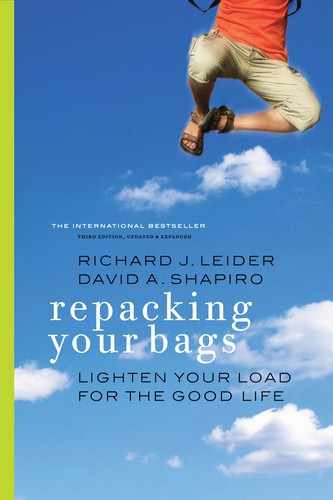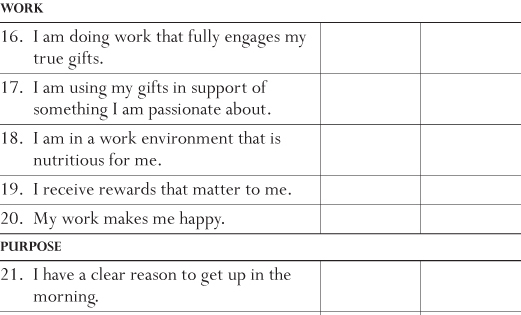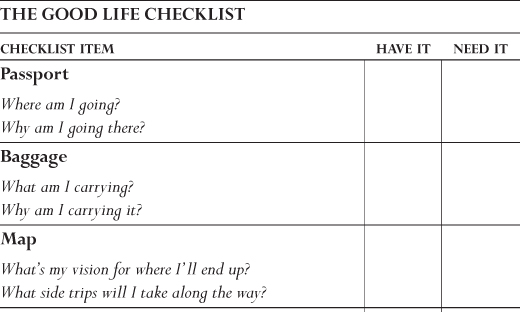REPACKING JOURNAL
The Good Life Inventory
To find out how well your current version of the good life fits your desired vision of “living in the place I call home, with the people I love, doing the right work, on purpose,” rate each question by numbering one to seven, with seven being best. For each question, write a score from one to seven, based on how well it fits your vision of the good life.
A second column is provided for use with a Repacking Partner. Have your partner fill out that column — rating you — and then discuss the results afterwards. Or, to make it even more interesting, make a copy of the Inventory, and give it to your partner. Each of you can then complete both columns, rating yourselves and each other. That discussion afterwards promises to be twice as compelling.
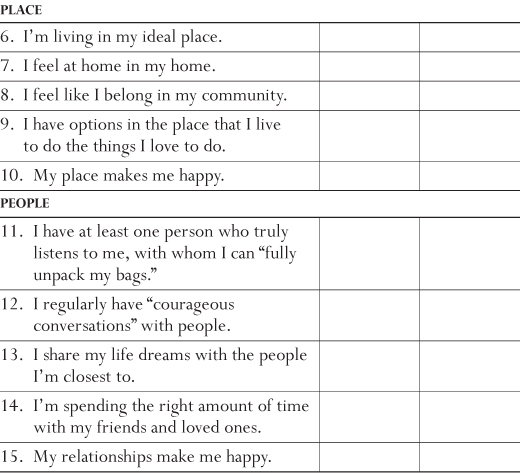
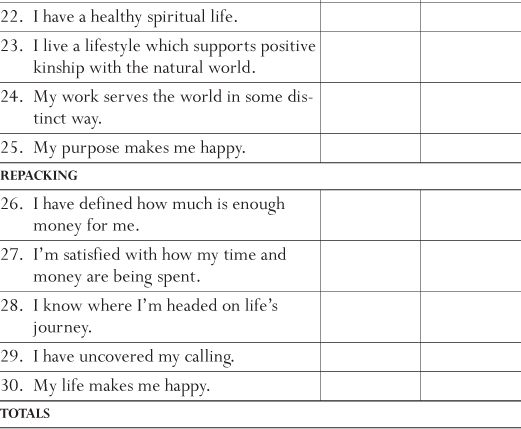
180+: |
Your life fits your definition of the good life. Enjoy your good fortune and assist others in attaining a similar quality of life. |
150-180: |
Parts of the Good Life formula are missing. Explore ways to “keep the small promises you’ve made to yourself.” |
120-150: |
Your current life/work is adequate, based on your vision of the good life. But what’s up ahead? |
90-120: |
Your current life/work does not fit your vision of the good life. Choose your timetable and set priorities for making changes. |
Under 90: |
Your life/work is a poor fit for your vision of the good life. It looks like it’s time for “courageous conversations” and choice. Now! |
Having completed this exercise, sit quietly for a few moments and reflect on your Good Life Inventory. Take a look at your life. What do you want? How will you know when you get it? Are you living in the Place you belong? Are you living with the People you love? Are you doing the right Work? Are you living and working On Purpose? What do you need to “unpack” to live the Good Life? What do you need to “repack”?
REPACKING JOURNAL
The Good Life Checklist
As you went through The Good Life Inventory, what you were doing, essentially, was creating a customized trip checklist, or what we call The Good Life Checklist.
The Good Life Checklist is simply a way to make sure that you’re bringing the essentials with you on your journey. And at the same time, not bringing way too much. A way to avoid the “Packing Principle.”
You’re taking stock of where you are and how you’ve gotten here. You’re examining the choices you’ve made in your life and trying to determine if the decisions still serve you. You’re seeing if you still have the answers … or if even the questions have changed.
The Good Life Checklist is a tool to eventually help you decide what you’ll need to carry on the next part of your journey. It’s designed to help you identify what you’re carrying (and what you’re not) and what you really need for the trip ahead.
The Good Life Checklist isn’t a test. Think of it more as a resource for planning. There are no right or wrong answers. The point is simply answer as truthfully as possible and learn as much about yourself as you possibly can.
Use The Good Life Checklist below to take a look at the next phase of your life. See if you’re carrying these items, or if some of the other things you’re lugging are taking up all of the room.
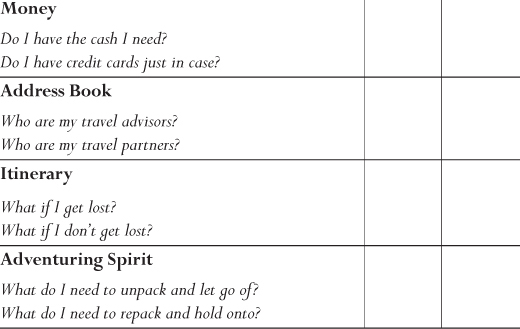
The Good Life Checklist Check-In
Having completed The Good Life Checklist, you may be asking yourself, “What do I really need to get where I’m going, anyway?”
The Good Life Checklist provides you with a structure for discussing what you’re carrying (and what else you may need) with others.
Courageous Conversation is an important part of The Good life Checklist.
Use the checklist in a discussion with a Repacking Partner to explore questions like:
• What type of bag (backpack, attaché case, duffel bag, etc.) best illustrates where I am and where I’m going next?
• What are my hopes and fears for the next leg of my journey?
• What is preventing me from getting where I’m going and what is weighing me down?
• Who are my current travel partners and who else might I seek out?
Keep the dialogue open and alive with a willingness to share as deeply as feels comfortable. Remember, this is about unpacking and repacking. The more fully you can unpack your innermost thoughts and feelings, the more vital your discussions will turn out to be.
At the same time there’s no need to turn your conversations into therapy sessions. They should be fun — or at least not too painful. Like your life, they should be filled with all the stuff you need, and free from all the stuff you don’t.
Each of our lives is, in fact, a short trip. In the grand scheme of things, we’re penciled in for a very brief journey. On the other hand, this is all we’ve got. So it’s no surprise that many of us go through life weighed down by the importance of it all, crushed beneath our load of literal and figurative baggage.
You can gain insight into how to lighten your load by imagining yourself setting out on a journey into the wilderness. If your pack is too heavy, it means you’re too attached to the life you are leaving behind. If it’s too light, it means you may not have enough to stay alive. The question becomes “How much is enough?” The weight of your pack ultimately determines the quality of your trip.
Since the more we have, the more we have to carry, entering the next phase of our trip requires lightening our load — not just physically but also emotionally. Like trekkers on safari, we inevitably have to ask, “What do I really need to carry?”
In the middle stages of a trek people often get tired because they’re carrying too much. They lose their sense of joy because they’re weighed down by all their stuff. They experience a version of the distinction that comedian George Carlin draws so eloquently between our “stuff” and other people’s “stuff.” In his routine, “A Place for My Stuff,” our own stuff is “stuff,” while other people’s stuff is “shit.” During a trek people often come to believe that their own stuff is shit, too.
To many of us during different stages of life, carrying our baggage starts to feel like an all-or-nothing choice. We get buried in responsibilities and attachments, and want to either chuck them all or just give up. Often this is what’s behind the traditional midlife crisis that sports car dealers know so well.
On treks in Africa most people don’t have a problem knowing what to carry. Their problem is knowing what to leave behind.
The trick is to find the balance between what to carry and what to leave — so you have all you need, but need all you have.
REPACKING JOURNAL
Creating a Repacking Group
It is not necessary to go it alone.
We were not destined to struggle all by ourselves, even if at the core of our lives we have to find our own way. It can be very reassuring and quite motivating to see others engaged in the same explorations as your own. Listening to and sharing with people that are similarly discovering what it means to repack can make the process seem more real and more accessible. In a variety of ways, people in this kind of supportive group feed off one another’s energy, enthusiasm, stories, and insight. All benefit as a result.
A Repacking Group inspires us to clarify our own vision of the good life, and to live it as fully as possible. Doing so reduces the likelihood that we will meander through life and end up regretting choices we made or failed to make. Having a group to rely on connects us to others who share our interests and acts as an antidote to social isolation.
The Repacking Group challenges us to discover the feeling of aliveness — the belief that “I’m on course.” It releases the power underlying a sense of purpose and vision.
Even though reading the book can be a powerful growth experience in itself, the presence of other individuals in a group setting will lend strength and breadth to the content. Your group can be a real source of inspiration, mutual support, and the formation of lasting friendships. So many individuals are searching for “what’s next?” in their lives that it could even be the beginning of a growth-support network in your region.
The following discussion section is your guide for leading a group exploration into the issues surrounding unpacking, repacking, and living the good life.
Using selections from the text of Repacking Your Bags, and with the help of a facilitator, a Repacking group can offer the opportunity for us to reflect on our lives. The meetings can be held at someone’s home on an evening or for four weekly (or monthly) meetings.
Each Repacking group is an organic entity with a personality and intelligence all its own. The guidelines here are offered as a basic structure upon which you can build. Starting a Repacking group can provide a fun way to begin and sustain the process of taking creative control of your life, while helping others to do the same.
Membership
The ideal size for a lively discussion is around six to eight people, assuming that it is a participative group. When deciding how many people to include in your group, however, you must take into account other factors, such as busy schedules, that can often keep several people from attending. The best strategy is to have enough people join the group so that you are assured of six to eight participants at the meeting(s).
You are advised to restrict membership to those who are seriously committed to the Repacking process. It undermines the energy of the group to allow dabblers at your sessions, for example, group members’ spouses or partners who are not themselves seeking a new experience of repacking.
Group members should be expected to attend all sessions, to complete readings and inventories, and to fully participate in group discussions. Each participant should have a copy of Repacking Your Bags.
Leadership
Without clear direction and a well-focused agenda your Repacking gatherings run the risk of degenerating into chat, gossip, or gripe sessions in which energy and time are expended but little is accomplished. In order to avoid this we strongly suggest that your group designates a facilitator for the session(s). It will be the facilitator’s responsibility to set the meeting agenda and to keep the group focused and moving forward.
The role of the facilitator is to keep people on track, to make certain that there is a positive dialogue maintained throughout, and that the group does not get involved in personal problem-solving or therapy. This does not mean that the input of individuals is not welcome. Actually it is essential, but the primary goal is the personal understanding and application of the exercises and discussion. The facilitator is not a guru, but rather a fellow participant and explorer.
Before facilitating the Repacking group, take the following steps:
1. Read Repacking Your Bags.
2. Complete The Good Life Inventory.
3. Let the material digest mentally for a day or two. Think about interesting information that would highlight the process.
4. Look over Repacking again and make notes. Prepare your own stimulating questions and insightful examples. Personal stories and anecdotes will often trigger discussions.
How Often Should You Meet?
The group format is totally flexible. It can be used in a short, two-hour session or a longer four-week or four-month format. It can be used in a coaching relationship or as part of a class or study group. If you are using the group process over time it is a good idea to meet on some predictable day, such as the first Wednesday of each month.
Where Should You Meet?
You could meet in a participant’s home or rotate among participants’ homes. You could use library rooms, local community centers, conference rooms, churches, synagogues, temples, spas and health clubs. Of course, conference calls or online discussions are a possibility for some types of groups.
Check that the site meets these criteria:
• Informal atmosphere
• Large enough to hold the maximum number of people expected
• Area is well-lit and temperature controlled
• Refreshments are available (or can be brought in)
What Are the Participant’s Responsibilities?
Again, each participant should have a copy of Repacking. Each should also bring a notebook or journal and a pen. The most obvious responsibility of participants is to read the book and complete The Good Life Inventory before the meeting. Other ground rules should be discussed at the initial meeting. The discussion might include issues of punctuality; what time meetings will begin and end; expectations of group members regarding level and consistency of participation; what happens if participants need to miss a session; and whether or not guests are allowed.
Structure
The facilitator is responsible for:
• Monitoring start and stop times.
• Encouraging dialogue from all participants.
• Reviewing the book and booklets carefully for specific discussion topics.
• Answering the following questions:
– Where will we meet?
– When will we meet?
– How will we notify people of meeting locations, times and study selections?
– How will we purchase the materials; individually or as a group?
Although there is a tendency with some facilitators to teach or preach, the Repacking lends itself to full group participation. When people participate they enjoy themselves more, and tend to get more out of the experience. Here are a few simple steps that will help you encourage group participation:
1. Practice good communication skills. Use eye contact and first names.
2. Ask open-ended questions that cannot be answered with a simple “yes” or “no.” For instance, “What are your thoughts about this?” or “How do you feel about that?” Ask for examples from the group’s experience.
3. Wait for a response. Don’t feel that you always have to fill silence. If you wait, the participants will take the initiative.
4. Get everyone to participate. Direct questions to people holding back. Use a “mood check” (go around) technique to begin.
5. Cut long-winded speakers. Redirect statements made to you as the facilitator. Turn away from the speaker and ask another participant to reply. Turn questions back to the group.
6. Keep on target and to the point. Don’t stray to unrelated subjects and don’t concentrate on small points for too long.
7. Give recognition. If you are impressed by a participant’s remark or insight, say so.
8. Keep your personal assessments hidden until several points of view have been aired and understood.
9. Show enjoyment of the group. Spend additional time with people before and after sessions and during the breaks.
10. Take frequent breaks so that individuals have time to communicate privately. Break the group up into pairs or triads for several of the exercises, and vary who is talking to whom. Smaller groups help to create a feeling of comfort and reduce anxiety. At the beginning it is also helpful to permit participants to talk a bit about themselves and what they are looking for out of the experience.
Guidelines
We are suggesting two different program structures to give you optional courses of action and to help you design your own program. You will probably want to make changes to complement the composition and objectives of your group, as well as your time requirements.
Option 1: One Session, two hours in length
Option 2: Four Sessions, two hours each
(same process as Option 1 but allowing more time)
Process
1. As soon as participants enter the room, try to develop rapport. Introduce yourself. If the group does not know each other, have them pick up a name tag as they walk in.
2. When everyone is in place and ready to begin, summarize the “Repacking” concept in your own words.
3. Ask starter questions to stimulate thinking and discussion. Do not feel obliged to pose the questions word for word. Use them instead to help you define, enhance and organize your own facilitation process.
a. What are some clear examples of repacking that you can recall? In your life? In your family? With people you know?
b. What is the role of repacking in life? Why is repacking necessary? When is it not necessary?
c. Review and share each others’ Good Life Inventory.
d. When do your feelings of living the good life typically emerge? When are they submerged?
e. How might we find a sense of purpose at this stage of your life?
f. Are you “living in the place you belong, with people you love, doing the right work, on purpose”? If not, which component(s) are lacking?
4. Have each member of the group share a Repacking story. What’s working and what isn’t? What support would help?
5. You can conclude with a “mood check.” Ask each person to share their insights and takeaways from the session.
